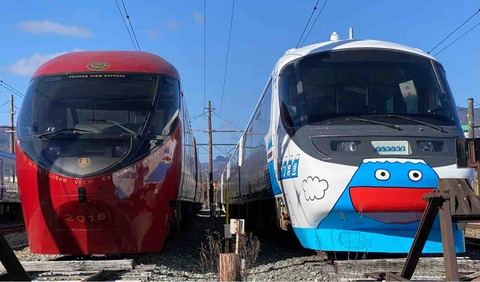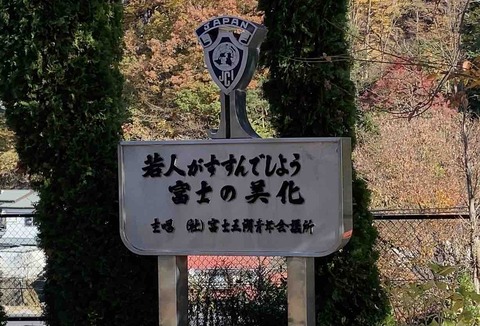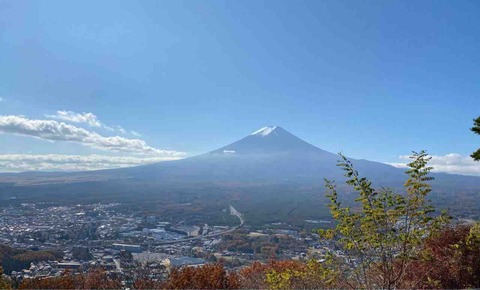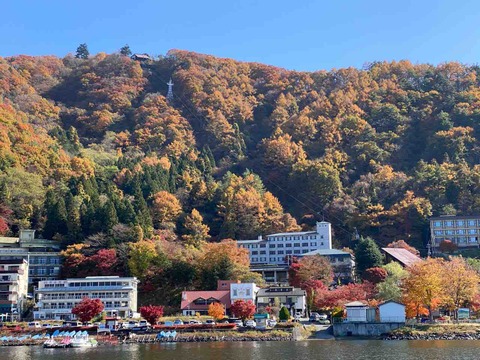富士急行
2019年、日増しに朝の冷え込む霜月。
今年部署を異動した僕は、新たな仕事に毎日バタバタで、なんだかどっと疲れてしまった。
酒を飲んだり美味いものを食ったりするのもストレス解消には良いが、こういう時は海や山といった雄大な自然を見ることが良い回復法だと思っている。
ある日、ふと富士山を見たくなり、金曜日の早朝に出勤する企業戦士たちを横目に特急富士回遊号に飛び乗ったのであった。
新宿駅に入線するE353系。この車両は「あずさ」「かいじ」の他に、中央ライナー・青梅ライナーをそれぞれ前身とする特急「はちおうじ」「おうめ」や、富士急行直通特急の「富士回遊」にも使用されている。
基本編成9両に付属編成3両で運用されている。
今回乗車する列車は基本編成9両(4〜12号車)が「あずさ3号」として、付属編成3両(1〜3号車)が「富士回遊3号」として運行する。
大月駅で両特急は切り離され、富士回遊は大月から先、富士急行線内を終点・河口湖まで走行する。
途中、富士山駅で進行方向が変わる。
富士急ハイランドを横目に列車は河口湖を目指す。
先日武蔵野線から引退した205系。富士急では元京葉車両センター所属の4編成と、元川越車両センター所属の3編成の7編成が元気に走っている。
そんなこんなで、河口湖に到着。
天気も良く、絶好の散歩日和である。
河口湖に停車中の6701編成。この編成は富士急開業90周年号となっている。
この6701編成と6702編成は、元八高線で使用されていたもので、前面が他の編成と異なっている。
ちなみに、現在6702編成はNARUTOラッピングが施されている。
隣のホームには高尾行きの211系が停車中。1日1往復のみ、この211系を使用したJR中央本線高尾駅までの直通列車が設定されている。
駅の横には元JR東海の371系で現在は富士急行8500系の「富士ビュー特急」と、元小田急20000形RSEで、現在は富士急行8000系の「フジサン特急」が留置中。
両者はともに小田急線〜JR御殿場線直通の「あさぎり」に使用された車両であり、富士急行では兄弟車ともいえる形式番号となって再会を果たしている。
「富士ビュー特急」の方は、みとーかデザインで高級感のある洗練された()イメージなのに対し、
「フジサン特急」は公募で選ばれた富士山のキャラクターをデザインした親しみのある()イメージとなっており、好対照を成している。
こら!どっちも元の方が数段カッコよかったとか言わないの!
残念ながら、新型コロナウイルスの感染防止のため、現在は富士ビュー特急とフジサン特急は終日運休となっている。
また、フジサン特急には休車の表示がされていた。
駅前にはモ1が保存されている。
富士山麓電気鉄道社紋。富士山と電気を意匠化したものだろう。
車体は野ざらしの割に保存状態は良い。
黄色いウランガラスと思われるおへその前照灯がイカしている。
能書き。
運転台はこんな感じ。
河口湖に向かって歩いていると、目の前に突然、説教臭いモニュメントが現れた。五七五になっている標語ですな。
しかし、なんだか「若人が」って言い回しが爺さんが上から目線で言ってる感じがするもんだから、
僕のようなひねくれた若者(そう若くもないが)はこの標語に敵愾心を燃やしてしまう。
富士は日本の宝です。爺さんも婆さんも、みんな綺麗にしましょうね~ということで、ええやないの~。

年季の入った感じのするお惣菜の店。
メニューは揚げ物のみなのかね?
コロッケ片手に歩きながら散策と思ったが、残念ながら準備中。
ん??居酒屋の看板には「貯金会承ります」の文字。
貯金会とは?あまり聞き慣れない単語である。
どうやら、山梨のこのあたりの地域では貯金会なる変わった風習があるらしい。
調べてみると、定期的に飲み会などを開催し、その際に飲み代とは別に定額のお金を積立てることを貯金会と言うそうだ。(無尽会、無尽講などとも言うらしい)
積み立てたお金はメンバーが順番に受け取ったり、メンバーで旅行に行ったりとさまざまな形があるらしい。
へぇ~。まだまだ知らないことがあるもんだ。
天上山(てんじょうやま)とは童話カチカチ山のモデルとなった山で、山頂からは富士山がよく見える
なお、天上山の山頂付近にある富士見台駅までは、河口湖富士山パノラマロープウェイ行くことができる。
ロープウェイからの眺望。
あっという間に標高1000メートルの富士見台駅に。
さすが、カチカチ山を売りにしているだけあって、ロープウェイの屋根上には可愛らしいウサギの人形が載っている。
天上山からの富士山。この日は天気も良く、眺めは最高だった。
また、この場所は山梨百名山の一つに数えられる三ツ峠の登山口となっている。
山頂にはたぬき茶屋という小さな茶屋がある。こちらで、思いのほかビッグサイズなたぬき団子を喫食。富士山の焼印が押されている。
甘辛いタレが疲れた体を癒してくれる。
この他に、きな粉がかかったうさぎ団子もある。
ここからもう少し上に登ったところに「武田信玄の戦国広場 絶景やぐら」というものがあり、富士山を背景に記念撮影ができるスポットとなっている。
再びロープウェイでカチカチ山こと天上山から下山し、お次は河口湖遊覧船アンソレイユ号に乗船。
湖上から、紅葉を眺めることにした。
湖上からの河口湖大橋と富士。
湖上からロープウェイの全景を。
河口湖の畔の木々は綺麗に色付いていた。
河口湖駅に戻り、ベンチで休憩。
自販機に見慣れないジュースを発見!味はクソマズでしたがね。
帰るころには見事に雲が…朝は雲一つない青空だったのに…朝撮っておくんだった…トホホ…
お土産に青い富士山カレーを買って帰った。味はクソマズ・・・かと思いきや割とフツーでした。